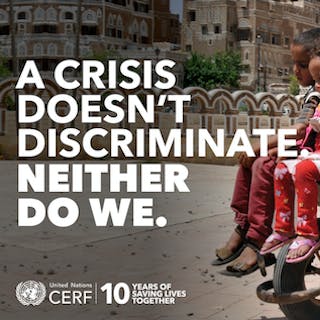
For families devastated by conflicts and natural disasters, every moment matters. Getting aid to people in their time of greatest need can sometimes be a matter of life or death.
That is why 10 years ago, the United Nations created the Central Emergency Response Fund, often known as CERF, to quickly and effectively get lifesaving aid to the people who need it, when they need it most.
Today, the UN is hosting an event to commemorate the 10-year anniversary of CERF and to pledge funds for its work. As UN leaders, Member States, and partners meet to raise awareness and support for CERF, here are answers to some common questions about the fund.
How does CERF work?
Governments, corporations, and individuals donate year-round to CERF, creating a pool of money that is available to get out the door immediately after an emergency strikes or as a crisis rapidly deteriorates. According to the UN, CERF makes money available when it is needed most: at the beginning of a crisis, when time is of the essence and it is critical that emergency relief operations get under way quickly.
Importantly, CERF also provides funding for neglected crises, such as conflicts, that are underfunded and have often disappeared from the headlines, yet where the need for help remains.
This year, CERF aims to raise $450 million to support aid work around the world. Funds raised will then be available to UN humanitarian agencies and other relief partners working on the ground to quickly provide food, water, shelter, medicine, and other relief supplies during an emergency.
Why was CERF created?
The UN General Assembly established CERF in 2005 to improve the rapid disbursement of humanitarian aid, so resources get to groups working on the ground faster and where they are needed most.
As the UN notes, “The countries that comprise the United Nations created CERF after recognizing that financial support for emergency response could be too slow and uneven. Lives were being lost while money was raised for new emergencies and support for long-lasting emergencies began to fade, often because they were far from the public eye.”
Simply put, CERF works to:
- Promote early action and response to reduce loss of life.
- Enhance response to time-critical requirements.
- Strengthen core elements of humanitarian response in underfunded crises.
What has been CERF’s impact?
Since its creation, CERF has allocated more than $4 billion in aid to 94 countries and territories facing conflict and disaster around the world. In 2014 alone, CERF supported humanitarian organizations working to respond to crises in 45 countries.
Annually, CERF helps provide 20 million people with health services; 8 million people with clean water and sanitation; 1 million people with shelter; and 10 million people with food.
Behind these numbers are real people, facing tragedy and receiving help in their time of greatest need.
Speaking about the important work of the fund, Secretary General Ban Ki-moon has said: “CERF is one of the most effective tools we have to help people face the immediate, devastating effects of natural disasters, armed conflict, and chronic emergencies. It is fast. It is reliable, and it saves lives.”
TAKE ACTION: To learn more about CERF, visit cerf.un.org and watch this video. To support the lifesaving work of CERF, click here. And to engage in the conversation about CERF’s 10 year anniversary, follow @UNCERF and the hashtags #CERF10 and #SavingLivesTogether.

